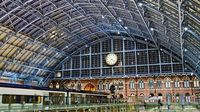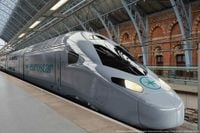For the first time in UK history, double-decker high-speed trains are set to glide through the Channel Tunnel, marking a dramatic leap for British and European rail travel. Eurostar, the cross-Channel rail operator, announced on October 22, 2025, that it has inked a €2 billion ($2.3 billion) agreement with French manufacturer Alstom to build up to 50 new two-level electric trains, named Eurostar Celestia. The first of these sleek, futuristic trains are scheduled to enter commercial service in May 2031, ushering in what the company hails as a new golden age for sustainable international travel.
The move is more than just a technological upgrade—it’s a strategic play in a rapidly shifting rail market. According to Sky News, Eurostar’s initial order includes 30 trains, with an option for 20 more, all based on Alstom’s Avelia Horizon design. These 200-meter-long trains will operate across five countries—UK, France, Belgium, the Netherlands, and Germany—serving flagship routes such as London St Pancras to Paris, Brussels, Amsterdam, and, for the first time, new direct services to Geneva and Frankfurt.
Eurostar CEO Gwendoline Cazenave described the order as a “milestone” that brings the company’s ambitious growth plans to life. “Placing this milestone order marks the concrete realization of Eurostar’s ambitious growth strategy—to reach 30 million passengers by investing in a brand-new fleet,” Cazenave said in a statement quoted by Condé Nast Traveller UK. “We’re particularly proud to bring double-decker trains to the UK for the very first time. Customers can expect a very special new train with Eurostar Celestia, which will offer exceptional comfort, a unique Eurostar experience and new surprises to be revealed.”
The new Celestia trains are designed for both comfort and capacity. Each train will offer around 540 seats—20% more than the current single-deckers—thanks to the double-decker layout. When two trains are coupled together, as is often done for Channel Tunnel services, that’s a staggering 1,080 seats per trip. Eurostar expects this expanded capacity to help boost annual passenger numbers from 19.5 million in 2024 to 30 million by the early 2030s, a 50% increase. On the flagship London-Paris route alone, the company hopes to grow annual passengers from 8 to 10 million by 2030, as reported by RFI.
But it’s not just about moving more people; it’s about moving them better. The new trains will feature a lower floor and a ceiling that’s 16 centimeters higher than existing models, creating a more spacious environment. Travelers will be able to choose which level they sit on, with no difference in price, and the trains will provide extra space for bicycles, wheelchair users, and more legroom. “By choosing Avelia Horizon to renew its fleet, Eurostar is confirming its desire to combine technological performance, energy efficiency and passenger comfort,” said Alstom CEO Henri Poupart-Lafarge, as reported by Trains.com. “This new-generation train, designed to meet the demands of international very high-speed traffic, embodies our vision of sustainable and competitive European mobility.”
Eurostar’s new fleet is also a win for the environment. The all-electric Celestia trains will be made from 97% recyclable components and 25% recycled materials, making them the operator’s most sustainable trains to date. They’re expected to consume up to 50% less energy compared to the current fleet, a significant step as Europe looks to lower transportation emissions and encourage people to choose rail over air or car travel. The trains will operate at speeds up to 186 miles per hour outside the Channel Tunnel and 100 miles per hour inside it, matching the impressive performance of Eurostar’s current service.
The investment isn’t limited to rolling stock. Eurostar will pour €80 million (£70 million) into developing its Temple Mills depot in East London, where the new fleet will be maintained. This expansion will create around 350 new jobs, a boon for the local economy and further evidence of Eurostar’s commitment to the UK as a central hub for its operations. Most of Eurostar’s jobs are already UK-based, and the depot’s upgrade is expected to future-proof the company’s maintenance capabilities as it expands its reach across Europe.
All these moves come at a crucial moment for Eurostar. For nearly three decades, the company has enjoyed a near-monopoly on passenger rail services through the Channel Tunnel, connecting London to the continent without the need for planes or ferries. But as Deutsche Welle and RFI report, that monopoly is under threat. Operators such as Italy’s Trenitalia, the UK’s Virgin Group (helmed by Richard Branson), Spain’s Evolyn, Dutch startup Heuro, and FS Italiane have all expressed interest in launching their own services through the Channel Tunnel. Britain’s rail regulator has ruled that Eurostar’s Temple Mills depot could be made available to other operators, potentially opening the door to new competitors as early as 2029.
Eurostar’s response to this looming competition is clear: innovate, expand, and lead. The new double-decker trains are not just a tool for growth, but a statement of intent. As Cazenave told the PA news agency, the company wants “bespoke trains as soon as possible,” ensuring it remains “leading the race” to meet the growing demand for international train travel. The company’s majority shareholder is the French state railway SNCF, after the British government sold its stake in 2015, a move that has left Eurostar with a distinctly continental flavor even as it deepens its UK roots.
For passengers, the changes promise a new era of choice and comfort. With more seats, more space, and more destinations—including direct trains to Geneva and Frankfurt—the Celestia fleet could fundamentally reshape how people travel between the UK and mainland Europe. And with sustainability at the heart of the design, Eurostar is positioning itself as the green alternative for international journeys, just as environmental concerns are coming to the fore across the continent.
As the first of the Celestia trains prepares to roll out in 2031, the race for the future of cross-Channel rail travel is well and truly on. Eurostar’s bet on double-decker innovation, expanded routes, and green technology is bold—but in a changing Europe, boldness might be exactly what’s needed.


